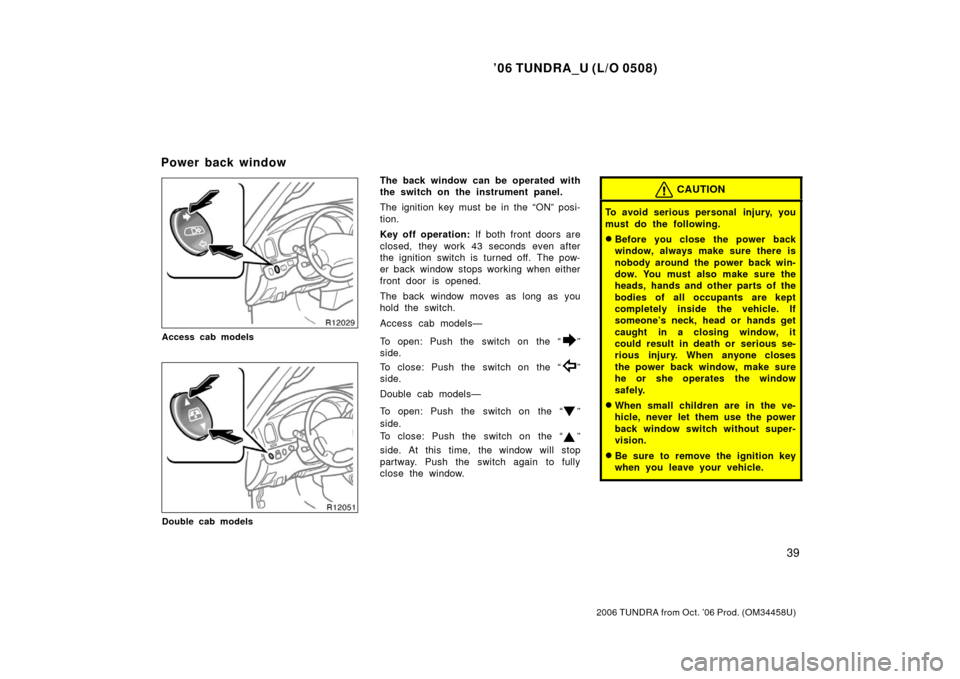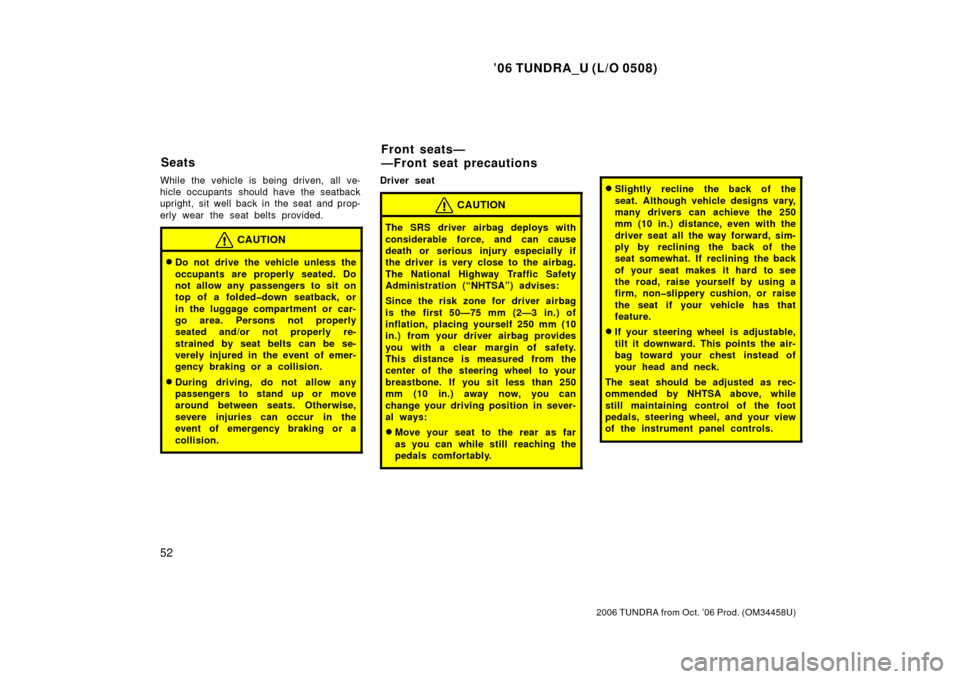Page 13 of 527
’06 TUNDRA_U (L/O 0508)
1
2006 TUNDRA from Oct. ’06 Prod. (OM 34458U)
OPERATION OF INSTRUMENTS AND
CONTROLS
Overview of instruments and controls
Instrument panel overview 2
. . . . . . . . . . . . . . . . . . . . . . . . . . . . . . . . . . . . .\
Instrument cluster overview 11
. . . . . . . . . . . . . . . . . . . . . . . . . . . . . . . . . . .
Indicator symbols on the instrument panel 13
. . . . . . . . . . . . . . . . . . . . . .
SECTION 1� 1
Page 14 of 527
’06 TUNDRA_U (L/O 0508)
2
2006 TUNDRA from Oct. ’06 Prod. (OM 34458U)
1. Side vents
2. Instrument cluster
3. Center vents
4. Personal lights
5. Garage door opener box or auxiliary
box
6. Side defroster outlet
7. Glove box
8. Power door lock switches
9. Power window switches
10. Manual transmission gear shift lever
11. Rear console box
12. Cup holders
13. Parking brake lever
14. Tire pressure warning system reset switch
15. Lower vent
16. Hood lock release lever
17. Window lock switch
18. Power rear view mirror control switches
Instrument panel overview
(standard and access cab models)
� Vehicles with manual transmission
Page 18 of 527
’06 TUNDRA_U (L/O 0508)
6
2006 TUNDRA from Oct. ’06 Prod. (OM 34458U)
15. Power outlets
16. Passenger airbag off switch
17. Ashtray
18. Cigarette lighter
19. “2WD/4HI” switch
(transfer mode selector switch)
20. “AUTO LSD” switch
21. Cruise control switch
22. Audio remote control switches
23. Tilt steering lock release lever
24. Toyota vehicle intrusion protection system (TVIP) indicator light
25. Instrument panel light control knob
Page 19 of 527
’06 TUNDRA_U (L/O 0508)
7
2006 TUNDRA from Oct. ’06 Prod. (OM 34458U)
1. Side vents
2. Instrument cluster
3. Center vents
4. Multi−information display
5. Personal lights
6. Auxiliary box
7. Electric moon roof switches
8. Side defroster outlet
9. Glove box
10. Power door lock switches
11. Power window switches
12. Seat heater switches
13. Rear console box
14. A/V input adapter
15. Headphone jacks and headphone volume control dials
16. Power outlets
17. Cup holders
18. Power outlet main switch
19. Tire pressure warning system reset switch
20. Lower vent
Instrument panel overview (double cab models)
Page 21 of 527
’06 TUNDRA_U (L/O 0508)
9
2006 TUNDRA from Oct. ’06 Prod. (OM 34458U)
1. Power back window switch
2. Power rear view mirror control switches
3. Roll sensing of curtain shield airbags
off switch (“RSCA OFF” switch)
4. Instrument panel light control knob
5. Headlight, turn signal and front fog light switches
6. Wiper and washer switches
7. Automatic transmission selector lever
8. Automatic transmission shift position “L” switch (“SHIFT L” switch)
9. Audio system or navigation system including audio system
(For the navigation system, see the
separate “Navigation System Owner ’s
Manual”)
10. Air conditioning controls 11. Front passenger ’s occupant classification indicator light/front
passenger ’s seat belt reminder light
12. Cargo lamp switch
13. Back window and outside rear view mirror defogger switch
14. Clock
15. Cup holder
16. Power outlets
17. Ashtray
Page 25 of 527
’06 TUNDRA_U (L/O 0508)
13
2006 TUNDRA from Oct. ’06 Prod. (OM 34458U)
Driver ’s seat belt reminder light∗
1
Low engine oil pressure warning light∗1
Low fuel level warning light∗1
Brake system warning light∗1
Charging system warning light∗1
Malfunction indicator lamp∗1
Anti −lock brake system warning light∗
1or
Front passenger ’s seat belt reminder light∗1
�Vehicle stability control system warning
light∗1
�Traction control system warning light∗1
�“AUTO LSD” system warning light∗1
SRS warning light∗1
Automatic transmission fluid temperature
warning light∗1 (four −wheel drive models)
Low windshield washer fluid level warning
light
∗ 1
Open door warning light∗1
Low tire pressure warning light∗1
Engine oil replacement reminder light∗1
(for vehicles sold in U.S.A.)
Indicator symbols on the instrument panel
Page 51 of 527

’06 TUNDRA_U (L/O 0508)
39
2006 TUNDRA from Oct. ’06 Prod. (OM 34458U)
Access cab models
Double cab models
The back window can be operated with
the switch on the instrument panel.
The ignition key must be in the “ON” posi-
tion.
Key off operation: If both front doors are
closed, they work 43 seconds even after
the ignition switch is turned off. The pow-
er back window stops working when either
front door is opened.
The back window moves as long as you
hold the switch.
Access cab models—
To open: Push the switch on the “
”
side.
To close: Push the switch on the “
”
side.
Double cab models—
To open: Push the switch on the “
”
side.
To close: Push the switch on the “
”
side. At this time, the window will stop
partway. Push the switch again to fully
close the window.
CAUTION
To avoid serious personal injury, you
must do the following.
�Before you close the power back
window, always make sure there is
nobody around the power back win-
dow. You must also make sure the
heads, hands and other parts of the
bodies of all occupants are kept
completely inside the vehicle. If
someone’s neck, head or hands get
caught in a closing window, it
could result in death or serious se-
rious injury. When anyone closes
the power back window, make sure
he or she operates the window
safely.
�When small children are in the ve-
hicle, never let them use the power
back window switch without super-
vision.
�Be sure to remove the ignition key
when you leave your vehicle.
Power back window
Page 64 of 527

’06 TUNDRA_U (L/O 0508)
52
2006 TUNDRA from Oct. ’06 Prod. (OM 34458U)
While the vehicle is being driven, all ve-
hicle occupants should have the seatback
upright, sit well back in the seat and prop-
erly wear the seat belts provided.
CAUTION
�Do not drive the vehicle unless the
occupants are properly seated. Do
not allow any passengers to sit on
top of a folded�down seatback, or
in the luggage compartment or car-
go area. Persons not properly
seated and/or not properly re-
strained by seat belts can be se-
verely injured in the event of emer-
gency braking or a collision.
�During driving, do not allow any
passengers to stand up or move
around between seats. Otherwise,
severe injuries can occur in the
event of emergency braking or a
collision.
Driver seat
CAUTION
The SRS driver airbag deploys with
considerable force, and can cause
death or serious injury especially if
the driver is very close to the airbag.
The National Highway Traffic Safety
Administration (“NHTSA”) advises:
Since the risk zone for driver airbag
is the first 50—75 mm (2—3 in.) of
inflation, placing yourself 250 mm (10
in.) from your driver airbag provides
you with a clear margin of safety.
This distance is measured from the
center of the steering wheel to your
breastbone. If you sit less than 250
mm (10 in.) away now, you can
change your driving position in sever-
al ways:
�Move your seat to the rear as far
as you can while still reaching the
pedals comfortably.
�Slightly recline the back of the
seat. Although vehicle designs vary,
many drivers can achieve the 250
mm (10 in.) distance, even with the
driver seat all the way forward, sim-
ply by reclining the back of the
seat somewhat. If reclining the back
of your seat makes it hard to see
the road, raise yourself by using a
firm, non�slippery cushion, or raise
the seat if your vehicle has that
feature.
�If your steering wheel is adjustable,
tilt it downward. This points the air-
bag toward your chest instead of
your head and neck.
The seat should be adjusted as rec-
ommended by NHTSA above, while
still maintaining control of the foot
pedals, steering wheel, and your view
of the instrument panel controls.
Seats Front seats—
—Front seat precautions